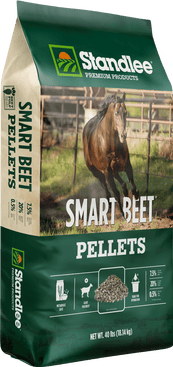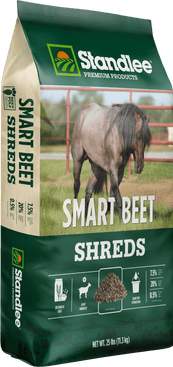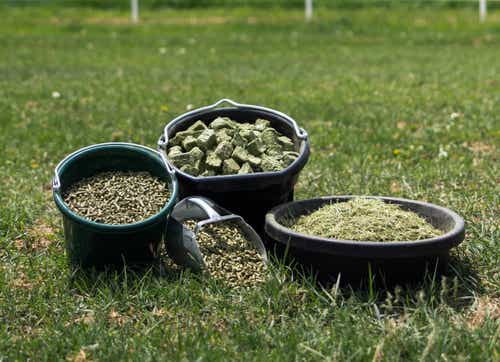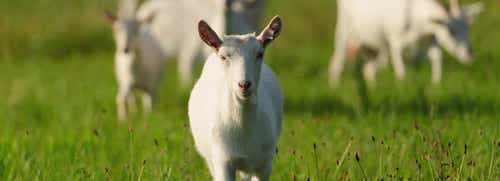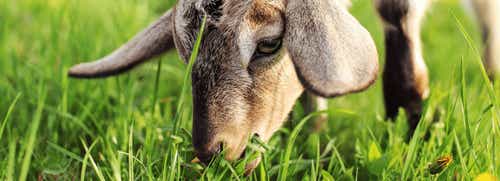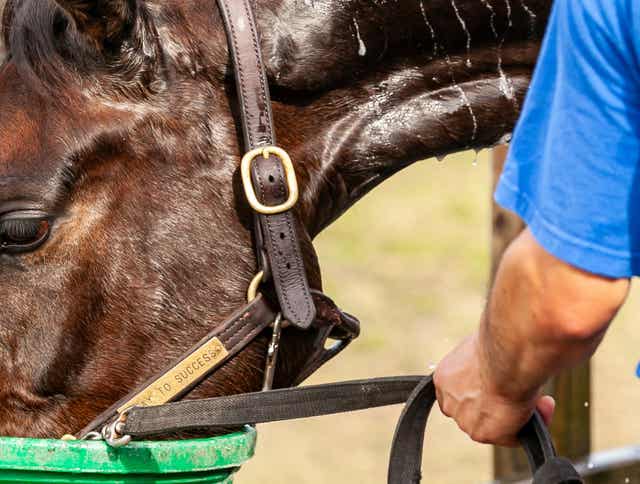
Heat Stress in Horses: Understanding Symptoms and Prevention
As we plan on riding in the summer months there are several environmental factors we must keep in mind. High temperature, high humidity, lack of air movement, poor ventilation, and dehydration all increase the danger of serious heat and sun related problems for horses, especially when they are expected to perform at intense levels.
Heat stress in horses is a concern, especially during the hot summer months or in regions with high temperatures and humidity. This condition arises when a horse's body cannot effectively dissipate heat, leading to various health risks. Recognizing the symptoms and implementing preventive measures is essential for keeping your horse safe.
Signs of Heat Stress
During exercise, there is a significant increase in the amount of heat produced by working muscles. Muscles cannot transform energy into movement with 100% efficiency. Horses transform energy to movement at approximately 25% efficiency. As a result, some of the energy is lost in the form of heat. The rate of heat production by working muscles is proportional to how hard the muscles work. Therefore, the faster a horse goes the more heat it produces. The amount of heat a horse produces in a 100-mile endurance race would be enough to boil approximately 200 gallons of water. That's approximately 2 gallons per mile. Fortunately for the horse, it is able to dissipate around 97% of the heat it produces during an endurance race in cool-warm conditions. If not, its body temperature would increase by around 60°F/h. In response, a horse increases its sweating rate, moves more blood to the capillaries under the skin and increases its rate of breathing in an effort to release this build-up of heat.
Commonly Observed Signs of Heat Stress in Horses
- Profuse sweating
- No sweating
- Rapid breathing rate - panting (>20 breaths / min)
- Rapid heart rate (>50 beat/min)
- Skin that is dry and hot
- Unusually high rectal temperatures (>100.4°F)
A simple pinch test can basically determine whether a horse is dehydrated as a result of heat stress. When you pinch the horse's skin on the neck, it should resume its original position immediately. If the skin takes a while to resume to its normal position it could be assumed that the horse is somewhat dehydrated.
Horses and Heat Stress: Who is at Risk?
Obviously, horses that perform at high levels such as thoroughbreds, Standardbreds, endurance and other performance horses will be influenced by heat stress during their training and competition. However high-performance horses are not the only types of horses to be at risk. Foals, especially the very young, have very poor thermo-regulating ability. They can overheat simply standing in the very hot sun. Add to this some activity, such as following an upset mare up and down a fence line, or weaning, and a serious problem can develop quickly. Horses stabled in poorly ventilated barns, which are also fed a poorly digestible forage will produce a lot of heat during digestion, which can seriously affect horses prone to heat stress. Additionally, any horse that does not have access to salt and electrolytes will be at greater risk of suffering heat stress.
Special Considerations for Older or Overweight Horses and Heat Stress
- Regular veterinary check-ups: Older horses or those carrying excess weight should have regular check-ups to monitor their overall health and detect any early signs of heat-related issues.
- Proper diet and hydration: Older or overweight horses may require specific dietary adjustments to maintain a healthy weight and ensure adequate hydration.
By understanding these risk factors and taking necessary precautions, horse owners can help minimize the risk of heat stress and keep their equine companions healthy and comfortable.
Warning Signs and Treatment of Heat Stress in Horses
Horses that are breathing with great difficulty, appear distressed, become weak, develop diarrhea or signs of colic, or stop sweating are in serious distress and need immediate attention. A veterinarian should examine the horse as soon as possible and provide medical treatment. You should immediately get the horse into shade and hose or sponge it with cool or even cold water. Direct the hose to the insides of the legs and the head and neck areas where large blood vessels are located near the surface.
Use fans and encourage the horse to drink. It may take an hour or more to get all the vital signs back to normal. Horses that have seriously overheated tend to be more susceptible to overheating in the future. Horses that have suffered a serious episode should have 10 to 14 days of rest with some turnout and a gradual return to work.
Most horses adapt to summer weather if given time to adjust gradually. Use a little common sense and keep a close watch on horses for signs of distress. Horses that are overweight and not used to regular hard physical activity are at the greatest risk.
Preventing Heat Stress in Horses
Creating a suitable environment for horses is essential in preventing heat stress. Providing access to shade allows horses to escape direct sunlight and reduces the risk of overheating. Additionally, ensuring proper ventilation in stables or barns can help maintain a comfortable temperature for the horses.
Proper hydration is another key factor in preventing heat stress. Horses should have constant access to clean, fresh water. Regularly checking water sources to ensure they are available, clean, and free from contaminants is vital. Consider providing multiple water troughs in different areas to encourage horses to drink more frequently.
Managing exercise and workload is vital during hot weather. Adjust the intensity and duration of exercise to prevent overheating and exhaustion. Plan workouts during the cooler parts of the day, such as early morning or evening, and avoid strenuous activities during peak heat hours. Monitor your horse's behavior and signs of distress during exercise, such as excessive horse sweating, heavy breathing, or reluctance to continue.
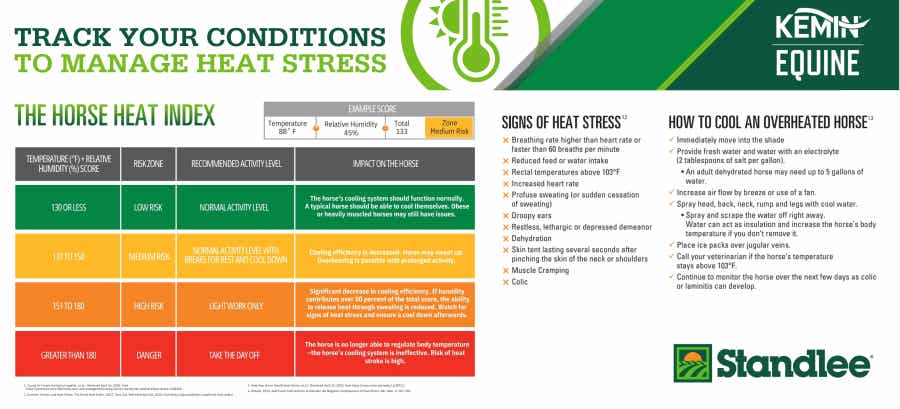
Track Your Conditions to Manage Heat Stress
It is important to recognize high-risk situations for heat stress in horses. Some factors to keep top of mind are:
- Extreme heat and humidity: Hot and humid weather conditions increase the risk of heat stress for horses. Pay close attention to the weather forecast and adjust your horse's routine accordingly.
- Strenuous exercise: Intense physical activity can quickly elevate a horse's body temperature. Avoid exercising horses during the hottest parts of the day and provide ample rest and access to water.
Horses and Heat Stress Management with Nutrition
A racehorse can lose up to 2.5 gallons of sweat per performance (work/race). This fluid isn't just water - it contains a lot of salt. These salts, when broken down into their chemical components, are referred to as electrolytes. These are typically groups of different salts that contain such electrolytes as sodium, potassium, chloride, magnesium and calcium. Electrolytes govern the transfer of water through cell membranes into or out of the cells. Thus, they function in getting the nutrients in and the waste products out. They are responsible for getting nerves to fire and muscles to contract. Essentially all of the physiological actions in the body require electrolytes. And importantly, they need to be present in the fluids in the appropriate amounts for these biochemical reactions to proceed in an orderly manner.
Prevent Overheating in Horses Using Nutrition
To understand how to use nutrition to prevent overheating in horses we must first understand fully how the digestive system works and creates heat.
Dietary fiber is the portion of the feed not broken down by the horse’s own digestive enzymes and is the structural component of plant material. Some of this fiber can be digested by microbial enzymes, particularly cellulose and hemicellulose. On the other hand, lignin – another fiber form – is not digestible and will be passed in the feces.
For this reason, the type of dietary fiber influences its nutritional value. Overly mature hay will have relatively high amounts of lignin, which reduces its digestibility and, therefore, its value as a dietary source of nutrients and energy. However, young hay, beet pulp, and soy hulls have much less lignin and much more digestible fiber. They are, therefore, much more valuable to the horse as an energy source.
The horse’s digestive system works best when it is fed a predominantly forage diet on an almost continuous basis. When feeding horses in hot conditions, make sure you are supplying them with highly digestible forage sources and avoid feeding poor quality over mature hays. It is also important to remember that the cecum and large intestine are an important reservoir of fluids that are rich in nutrients and electrolytes from the horse’s feed. Fiber in the gut helps to create this reservoir of fluids. While it is important to feed highly digestible fiber sources, it is just as critical to maintain an adequate amount of fiber in the diet. Never feed less than 1% of the horse’s body weight in fiber; ideally the horse should receive 1.5 to 2% of its body weight in fiber each day. Following these nutritional guidelines will help keep the horse hydrated, its digestive system working smoothly, and prevent overheating.
Low Heat Feeding for Managing Heat Stress in Horses
Certain feeds create more heat from digestion than others. Fiber is digested in the hindgut by microbial fermentation and depending on the quality of the fiber, can create a lot of heat during digestion. During very hot conditions it is important to include highly digestible fiber sources such as beet pulp to decrease the thermal load of digestion.
Standlee Smart Beet Pulp Products
Smart Beet Pellets or Smart Beet Shreds are an excellent addition to any ration as a low starch, low protein, highly digestible food source. They are metabolically safe, and when soaked, increase water intake for animals. It is a great option for senior horses, those who are carbohydrate- sensitive, and horses in need of additional energy and digestible fiber. If you own other livestock animals such as cattle, goats, and sheep. Beet pulp is a great option for them as well!
By Tania Cubitt, PhD
Performance Horse Nutrition

